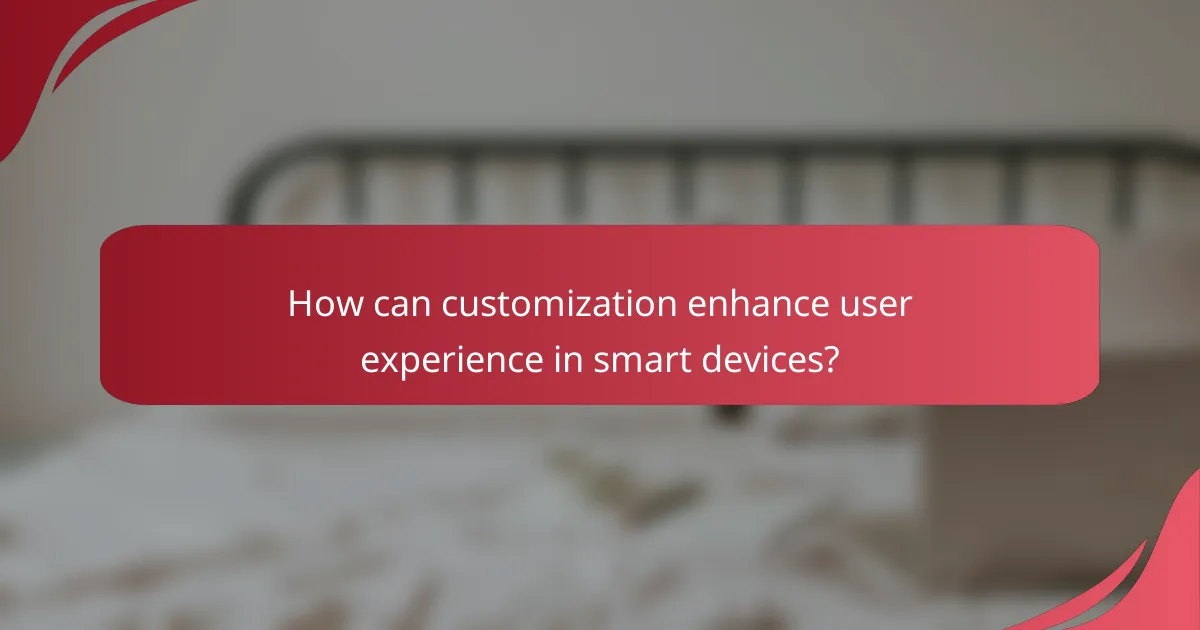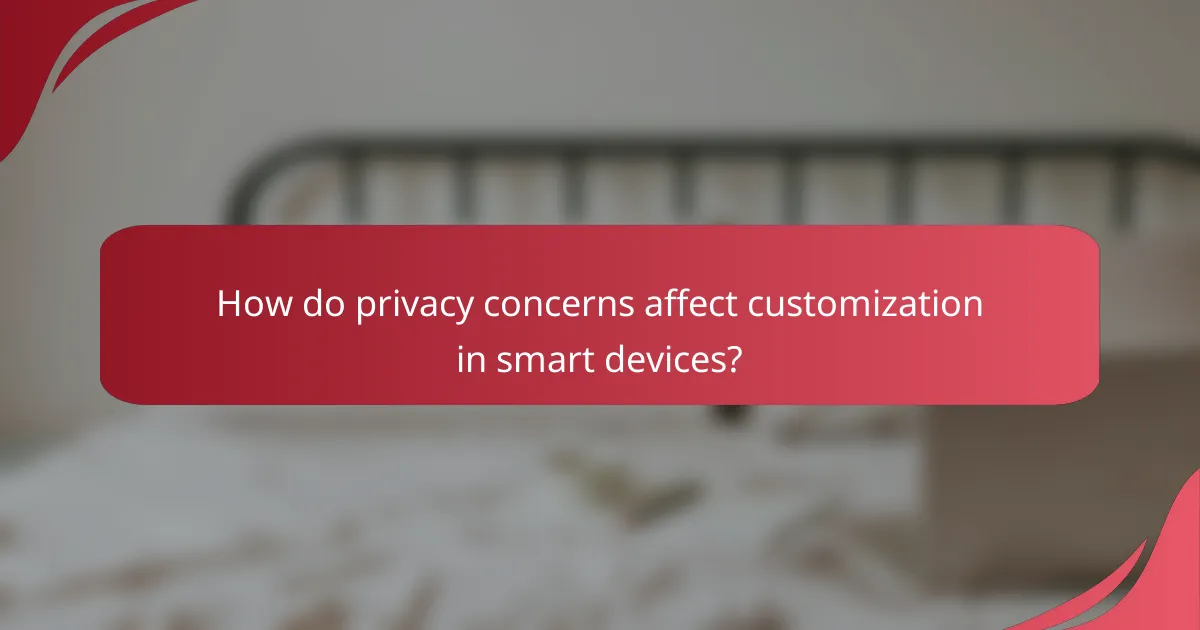Customization plays a crucial role in enhancing user experience with smart devices by enabling individuals to adjust settings and features according to their personal preferences. This tailored approach not only increases user satisfaction but also fosters deeper engagement, as devices like the Amazon Echo and Google Nest Hub adapt to individual needs, creating more relevant and meaningful interactions.

How can customization enhance user experience in smart devices?
Customization significantly enhances user experience in smart devices by allowing users to tailor settings and features to their preferences. This personalization leads to greater satisfaction, improved functionality, and more relevant content delivery, ultimately fostering deeper engagement with the device.
Increased user satisfaction
When users can customize their smart devices, they often report higher satisfaction levels. Personalization allows individuals to adjust settings such as display brightness, notification preferences, and app layouts, making the device feel more intuitive and aligned with their needs.
For example, a user might prefer a dark mode interface for their smartphone, which can reduce eye strain and enhance usability in low-light conditions. This level of control can lead to a more enjoyable user experience and increased loyalty to the brand.
Improved device functionality
Customization can significantly improve the functionality of smart devices by enabling users to optimize features according to their specific use cases. For instance, smart home devices can be programmed to operate based on user routines, such as adjusting the thermostat when the user arrives home.
Additionally, users can prioritize certain apps or features, ensuring that the most relevant tools are easily accessible. This tailored approach not only enhances efficiency but also maximizes the device’s potential, making it more valuable to the user.
Tailored content delivery
Smart devices can deliver tailored content based on user preferences, which enhances engagement and relevance. For instance, streaming services often use algorithms to recommend shows and movies that align with a user’s viewing history and preferences.
Users can also customize news feeds or notifications to receive updates on topics that interest them, ensuring that the information they receive is pertinent and engaging. This level of personalization keeps users connected and encourages regular interaction with their devices.

What are the best smart devices for personalization?
The best smart devices for personalization include those that adapt to user preferences, enhance user experience, and improve engagement through tailored interactions. Devices like the Amazon Echo, Google Nest Hub, and Apple HomePod excel in these areas, offering unique features that cater to individual needs.
Amazon Echo with Alexa
The Amazon Echo, powered by Alexa, stands out for its extensive customization options. Users can personalize their experience by setting routines, choosing preferred music services, and integrating various smart home devices. This flexibility allows for a tailored environment that can adapt to daily schedules and preferences.
To maximize personalization, consider using Alexa’s skills, which are third-party applications that enhance functionality. For instance, you can enable skills for meditation, cooking, or news updates, ensuring that the Echo serves your specific interests. Regularly reviewing and updating these skills can keep the experience fresh and engaging.
Google Nest Hub
The Google Nest Hub offers a visually oriented approach to personalization, featuring a touchscreen display that allows users to customize their home screen with preferred apps and widgets. This device integrates seamlessly with Google services, making it easy to access personalized information such as calendar events, reminders, and tailored news feeds.
Additionally, the Nest Hub uses voice recognition to differentiate between users, providing personalized responses based on who is speaking. This feature enhances user engagement, as each family member can receive tailored information and recommendations. Regularly updating your preferences in the Google Home app can further refine the experience.
Apple HomePod
The Apple HomePod focuses on audio quality and smart home integration, allowing for a personalized listening experience. Users can customize sound settings based on their preferences and create playlists that reflect their musical tastes. The HomePod also integrates with Apple Music, providing curated recommendations based on listening habits.
Another key feature is the HomePod’s ability to recognize different voices, enabling personalized responses and music suggestions for each user. To enhance personalization, ensure that your Apple Music library is up to date and explore features like spatial audio for an immersive experience. Regularly adjusting settings can help maintain an engaging and tailored audio environment.

How does user engagement improve with smart device customization?
User engagement significantly improves with smart device customization by allowing users to tailor their experiences according to personal preferences. This personalization leads to increased satisfaction and a stronger connection to the device, ultimately enhancing overall user interaction.
Higher interaction rates
Smart device customization fosters higher interaction rates by enabling users to modify settings, interfaces, and functionalities to suit their needs. When users can personalize their devices, they are more likely to engage with features that resonate with their daily routines and preferences.
For example, a user may customize a smart home assistant to prioritize reminders for important tasks or events, leading to more frequent interactions. This tailored experience encourages users to explore additional features, increasing overall engagement.
Longer usage sessions
Customization contributes to longer usage sessions as users feel more invested in devices that reflect their individual tastes and requirements. When a device is personalized, users are likely to spend more time interacting with it, discovering new functionalities that align with their interests.
For instance, a fitness tracker that allows users to set personal goals and track specific metrics can lead to extended periods of use, as users are motivated to monitor their progress. This deeper engagement can translate into a more meaningful relationship with the device.
Enhanced loyalty to brands
When users experience significant customization options, their loyalty to brands tends to increase. Personalized experiences create a sense of ownership and satisfaction, making users less likely to switch to competitors.
Brands that offer robust customization features, such as customizable interfaces or tailored recommendations, often see higher retention rates. For example, a smartphone brand that allows extensive personalization of themes and app layouts can cultivate a dedicated user base that appreciates the unique experience provided.

What factors influence customization in smart devices?
Customization in smart devices is influenced by user preferences, device capabilities, and market trends. Understanding these factors helps manufacturers create products that enhance user experience and engagement.
User preferences
User preferences play a crucial role in the customization of smart devices. Individuals often seek tailored experiences that reflect their unique needs and lifestyles, such as personalized interfaces or specific functionalities. For example, a fitness enthusiast may prioritize health tracking features, while a casual user might prefer simplicity and ease of use.
To effectively cater to user preferences, manufacturers can implement feedback mechanisms, such as surveys or usage analytics, to gather insights on what features users value most. This data can guide design decisions and feature enhancements.
Device capabilities
The capabilities of a smart device significantly impact the level of customization available. High-end devices typically offer more advanced features, such as customizable settings and integration with various applications. For instance, a smart thermostat may allow users to set personalized schedules based on their daily routines.
However, lower-end devices may have limited customization options due to hardware constraints. It’s essential for users to understand the specifications of their devices to maximize the available customization features while avoiding frustration from unmet expectations.
Market trends
Market trends heavily influence how customization is approached in smart devices. As technology evolves, consumers increasingly expect more personalized experiences, driving manufacturers to innovate. For example, the rise of artificial intelligence has led to smarter devices that learn user habits and adjust settings automatically.
Staying informed about market trends can help users make better purchasing decisions. Engaging with reviews, tech blogs, and industry reports can provide insights into which devices offer the best customization options and align with current user demands. This proactive approach can enhance overall satisfaction with smart devices.

How do privacy concerns affect customization in smart devices?
Privacy concerns significantly influence how customization is implemented in smart devices. Users are increasingly wary of how their personal data is collected and used, which can limit their willingness to engage with personalized features.
Data security issues
Data security issues arise when smart devices collect sensitive information, such as location and usage patterns. If this data is not adequately protected, it can be vulnerable to breaches, leading to unauthorized access and misuse. Users may hesitate to customize their devices if they fear their data could be compromised.
To mitigate these risks, manufacturers should implement strong encryption protocols and regularly update their security measures. Users should also be aware of privacy settings and opt for devices that prioritize data protection, ensuring their personal information remains secure.
User trust levels
User trust levels play a crucial role in the acceptance of customization features in smart devices. When users trust a brand or device, they are more likely to share their data for personalized experiences. Conversely, a lack of transparency about data usage can erode trust and deter users from utilizing customization options.
Building user trust involves clear communication about data practices and offering robust privacy controls. Brands can enhance trust by providing easy-to-understand privacy policies and allowing users to manage their data preferences effectively. Regularly engaging with users about their privacy concerns can also foster a more trusting relationship.

